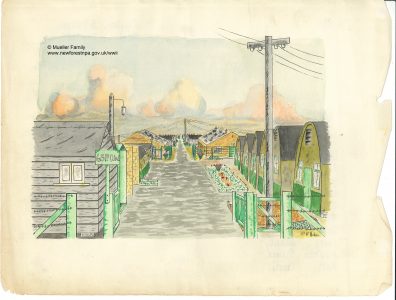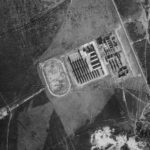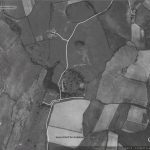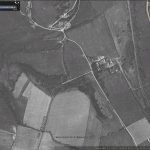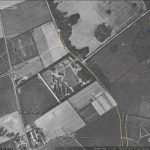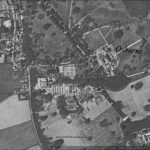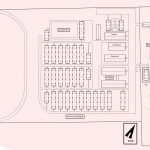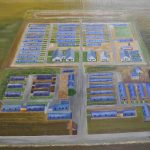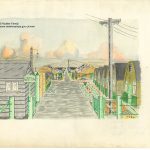Setley Prisoner of War Camp – Overview
Prisoner of War Camp 65 on Setley Plain was built in 1941 to hold Italian Prisoners of War. From 1944 the camp went on to hold German prisoners, and continued to do so until 1947. The camp was then handed over to the New Forest Rural District Council to house young families of returning servicemen, previously housed in Nissen huts at Beaulieu aerodrome. The camp had a shop, run by Harry Munden, and was in existence until the early fifties, when sufficient permanent council housing had been built.
During the war years, each morning and evening lorries were seen taking prisoners to and from their designated jobs in the Forest with a single guard, armed with his rifle. Italian POWs were photographed working at Denny Sawmill, Lyndhurst and there are photographs of the German POWs working in the gardens of local residents in Brockenhurst.
POWs also worked on the land and on the British Pathe website is a film Italian Prisoners 1941 showing POWs helping to get the harvest in on an English Farm. We don’t think it was filmed in the New Forest.
In 1943 following the Italian surrender, 100,000 Italians volunteered to work as ‘co-operators’. The camp became more like a hostel as the Italians were found new homes. Particularly after D-Day in 1944 German POWs need to be accommodated and Setley Camp 65 became a POW camp once again.
These were all “low risk” prisoners, happy their war was over, there are no known incidents involving searches for escaped prisoners. More high risk prisoners were housed at one of Camp 65’s satellite camps on the Isle of White and the very high risk POWs found themselves in camps in the north of the UK.
At the end of the war efforts were made to repatriate all prisoners of war and many returned to Germany. The project team is aware of three ex POWs that chose to stay in the UK after the war hoping to make a new life for themselves.
The German camp had a number of satellite camps or hostels, some of which were on the Isle of Wight. The translated Newsletter (No1.) helps to shed light on these hostels.
Osborne House
The whole camp community had waited with great anticipation for this evening, which was being held in commemoration of Osborne House’s first anniversary. On Sunday evening the time had finally come. The dining barrack was adorned with flowers and greenery to make it look as inviting and cosy as possible.
Newclose
A hostel which houses 80 men, is situated in deep isolation south of Newport. From the well-known mirror* a path leads to the hostel which snuggles its back to the hill as if looking for shelter. Plants flourish abundantly in the small hostel garden. Exotic trees with wonderful blossoms surround it and even now display a markedly summery appearance.
*Neither translation explains the use of this word
Beatrice Avenue
The hostel is a camp with 50 men, situated at the Southern edge of the town East Cowes with wonderful views over West and East Cowes and the sea. Apart from the round tents, the camp also boasts a barrack for dining and reading.
Whitewell (Whitwell)
True, we are one of the smallest hostels on the Isle of Wight, but we are in a beautiful location and housed in an old fashioned, castle like mansion which is surrounded by a respectable fruit and vegetable garden. Such a spacious house and such a beautiful garden need a lot of maintenance which can only be done in our spare time.
The possible locations of these sites are shown in the Google Earth images, showing the 1945 aerial photographs, included in this article. We will be uploading the translated text from these newsletters once they become available. Following the “documents and artefacts” link to find out more.
Further reading relating to Setley Camp that can be found on New Forest Knowledge:
- Follow the Setley Camp time line to see the main events relating to the camp.
- Follow 3D model to see our efforts to reconstruct the camp.
- Follow families to see peoples recollections of living at the camp after the war. if you lived there please add a comment with your recollections.
- Follow Post war civilian occupation to see some photographs of the camp from the late 1940s.
- Read more about one of the Italian POWs Benedetto Spano.
- Many item were made by the POWs for local residents, for example find out about the Italian: chess set.
- A range of documents and artefacts have come to light from the camp, find out more
Memories of Setley
- Families in Lymington ask to have a German POW for Christmas
- Listen to extracts of the oral history interview with Hans Strehlau once a German POW at Setley.
- Memories of a motorcycle ride to Setley
- Memories of a Motor Transport Officer at Setley POW Camp 65
we have also produced an animated flythrough of the camp’s 3D reconstruction.


